- How Pranayama Help in Diabetes?
- Bhastrika Pranayama
- Bhramari Pranayama
- Kapalbhati Pranayama
- Sitali and Sitkari
- Anulom Vilom
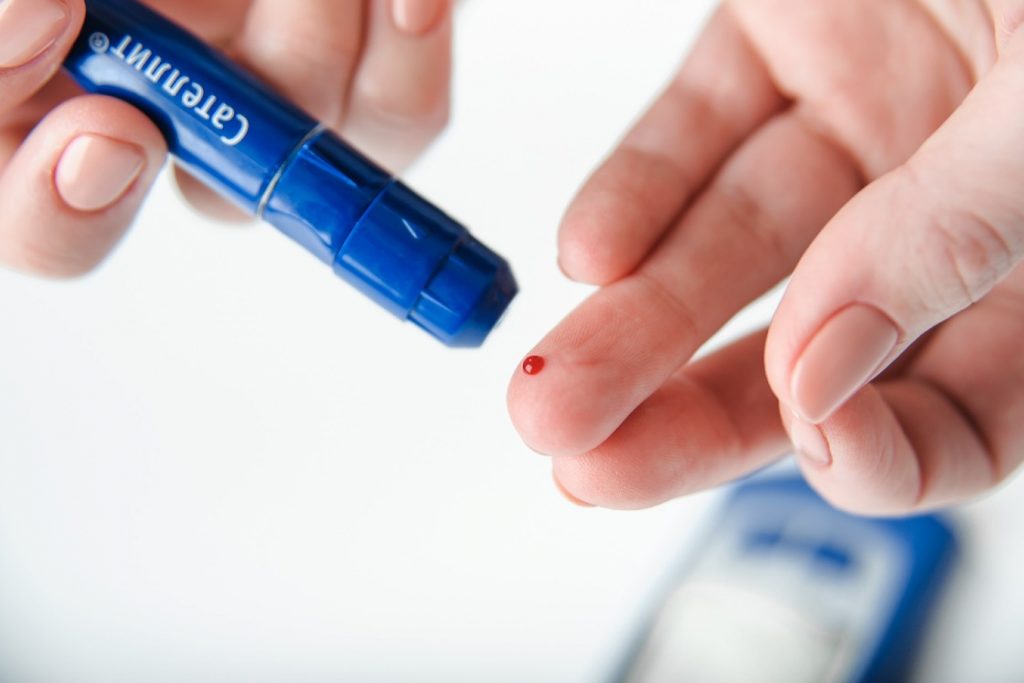
Diabetes is a major global health problem, affecting over 422 million people. In India, the situation is even more severe, with about 77 million adults having type 2 diabetes and nearly 25 million more at high risk of developing it.
Managing diabetes involves keeping blood sugar levels stable, which can be challenging. Along with traditional treatments, yoga can be a helpful tool. One aspect of yoga, known as pranayama, includes special breathing exercises that can aid in managing diabetes.
What causes diabetes?
Diabetes is a chronic condition with high blood glucose levels, caused by insufficient insulin production or poor insulin use. Insulin, a hormone from the pancreas, helps store excess glucose in liver cells.
Key factors include:
- Sedentary Lifestyle: Prolonged inactivity, especially with a family history of diabetes, raises the risk of developing the condition.
- Being Overweight or Obese: High-calorie foods lead to weight gain, which can impair insulin function and raise blood glucose levels.
- Hypertension: High blood pressure increases the risk of type 2 diabetes, as shown by the Journal of the American College of Cardiology (JACC) data from over 4 million adults.
- Genetic History: Both environmental factors and genetic predisposition contribute to type 2 diabetes.
- Sedentary Lifestyle: A sedentary lifestyle, or sitting for long periods, increases the risk of type 2 diabetes, especially if there is a family history of the condition. Lack of physical activity contributes to this risk..
How does pranayama help in diabetes?
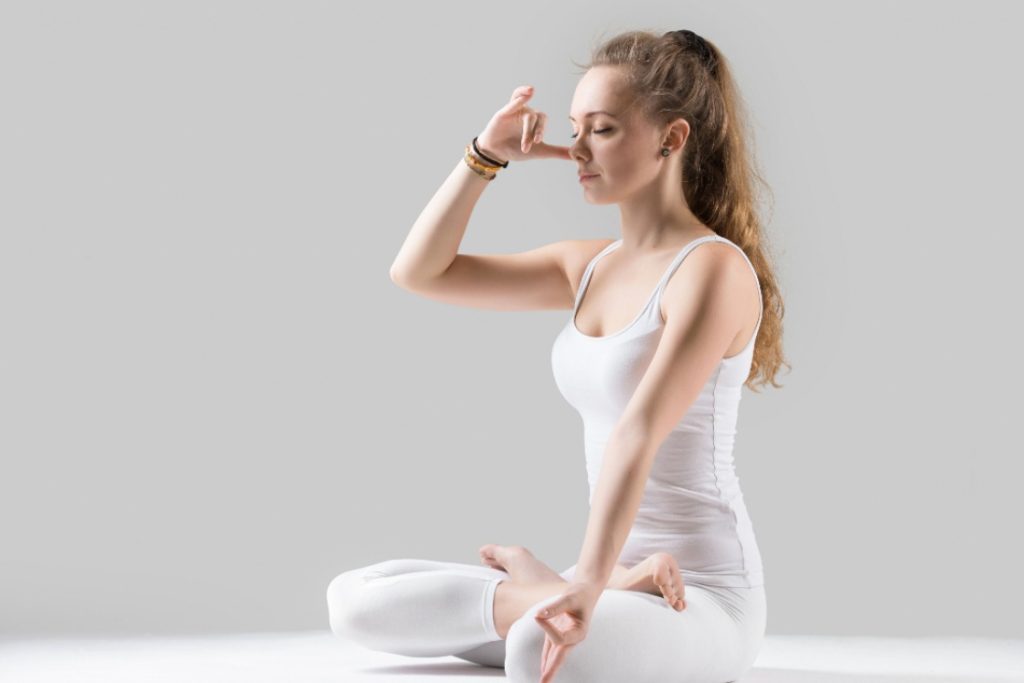
Pranayama, the practice of controlling breath in yoga, can be beneficial for managing diabetes. By regulating our breath, Pranayama influences various body systems and promotes better insulin function.
Here’s how Pranayama works for diabetes:
- Stimulates the Hypothalamus: Vigorous techniques like Bhastrika and Kapalbhati stimulate brain regions such as the hypothalamus. This, in turn, affects the pancreas, enhancing insulin secretion.
- Regulates Metabolism: Pranayama boosts metabolic control by improving insulin function and increasing the activity of the metabolic system.
- Deep Breathing Benefits: Techniques like Dirgha Pranayama and Anulom Vilom involve deep, relaxing breaths that oxygenate the blood and remove toxins. This helps the pancreas produce insulin more effectively and regulates blood glucose levels.
- Enhances Cellular Metabolism: Regular practice of Pranayama also improves cellular metabolism and helps the glucagon hormone manage stored glucose, supporting overall blood sugar control.
Pranayama for diabetes: Techniques and benefits
| Pranayama Breathing Practices | Time/ Duration | Effects and Benefits Diabetic Person |
| Bhastrika Pranayama | Morning 3 minutes | Massage brain centers, metabolic control of insulin action. |
| Bhramari Pranayama | Morning & Evening 10 minutes each time | Control high blood pressure, relieves stress & anxiety. |
| Kapalbhati Pranayama | Morning 5 rounds, 120 strokes | Improve pancreas efficiency in insulin production, control glucose levels in the blood. |
| Sitali and Sitakari Pranayama | Evening 5-6 minutes | Lowers blood pressure, cooling effect. |
| Anulom Vilom Pranayama | Morning & Evening 5-10 minutes | Increase flow of oxygenated blood to brain, saves blood vessels from inactivity. |
1. Bhastrika pranayama
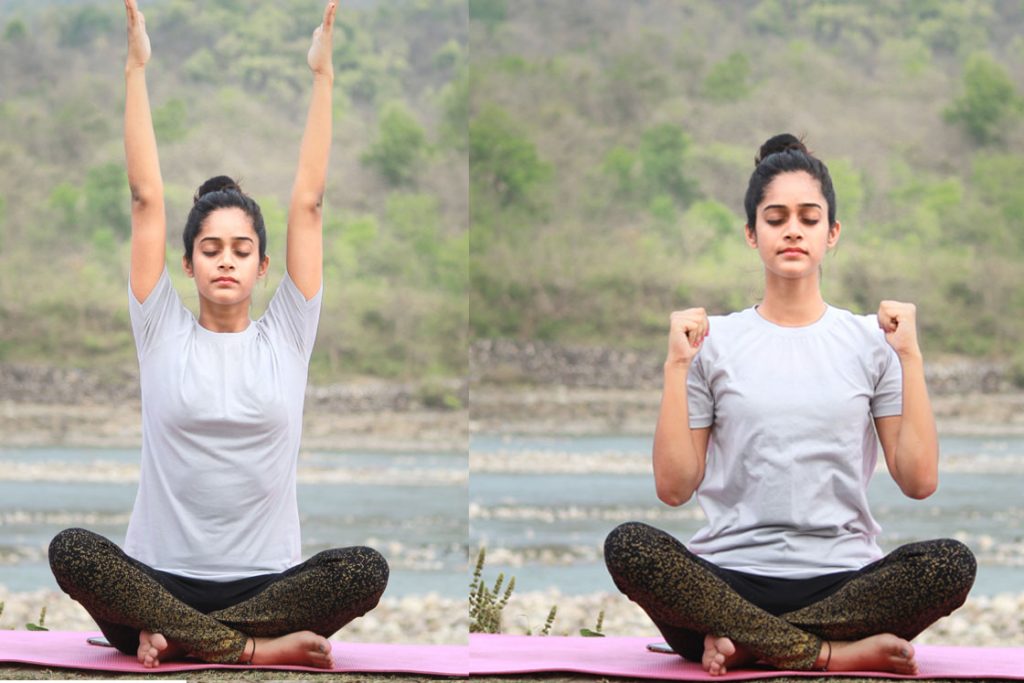
This fast breathing technique involves rapid inhale & exhale. Rapid breath movements stimulate certain brain centers responsible for the governance of insulin activity.
This breathing technique also called ‘bellows breath‘, bellows in a way that used to fan the fire in ancient times.
How to do Bhastrika Pranayama:
- Sit in a relaxing seated yoga pose: easy pose or lotus pose.
- Straighten and elevate your back by placing a folded blanket below the buttocks. However, Vajrasana (thunderbolt pose) is recommended for this action.
- Make fist with your hands, bend your elbow, and brings your hands next shoulder level.
- Now inhale, with inhale raise your hands straightly up and open the fist.
- On exhale, bring your hand back to the shoulder level and again close the fist.
- Do it rapidly with moderate breathing length.
- 20 breaths of bhastrika pranayama enough in one session.
Doing this pranayama regularly enhances the metabolism of the body and massages the whole brain.
How Bhastrika Pranayama helps in diabetes?
- Rapid inhalation and exhalation create a massaging effect on brain regions, stimulating the hypothalamus to influence the pancreas’s endocrine function.
- Enhances blood circulation, which boosts cellular metabolism.
- Produces warmth that helps burn triglycerides and fatty acids, reducing factors that contribute to insulin resistance.
Read More: Benefits of Bhastrika Pranayama
2. Bhramari pranayama

This breathing technique calms the mind and relieves stress & anxiety. It’s helpful in maintaining BMI by producing thyroxine hormone. An increase in BMI makes you overweight which increases the chance of developing the common type of diabetes.
How to do bhramari pranayama:
- Begin by sitting in seated yoga asana such as Padmasana or Sukhasana.
- Close your ears and eyes with your thumbs and forefingers.
- Now, inhale through your nostrils, let your lungs expand fully.
- Exhale with a ‘hmmm’ sound (like humming bee) producing through your throat.
- Feel the vibrations of humming sound reach throughout your body.
- Repeat breathing in this manner for 20 rounds in the morning and evening.
This has a relaxing and soothing effect on the nervous system.
How bhramari helps in diabetes?
- The vibrations produced during this breathing technique stimulate the thyroid gland to produce thyroxine, which helps maintain a healthy BMI (18.5 to 24.9) and reduces the risk of diabetes.
- Rapid expulsion of air compresses the stomach, massaging the pancreas and aiding in insulin secretion.
- The relaxing effect of the practice reduces stress, which lowers the activation of the hypothalamic-pituitary-adrenal axis and the sympathetic nervous system, thereby improving insulin secretion.
Read More: Benefits of Bhramari Pranayama
3. Kapalbhati Pranayama
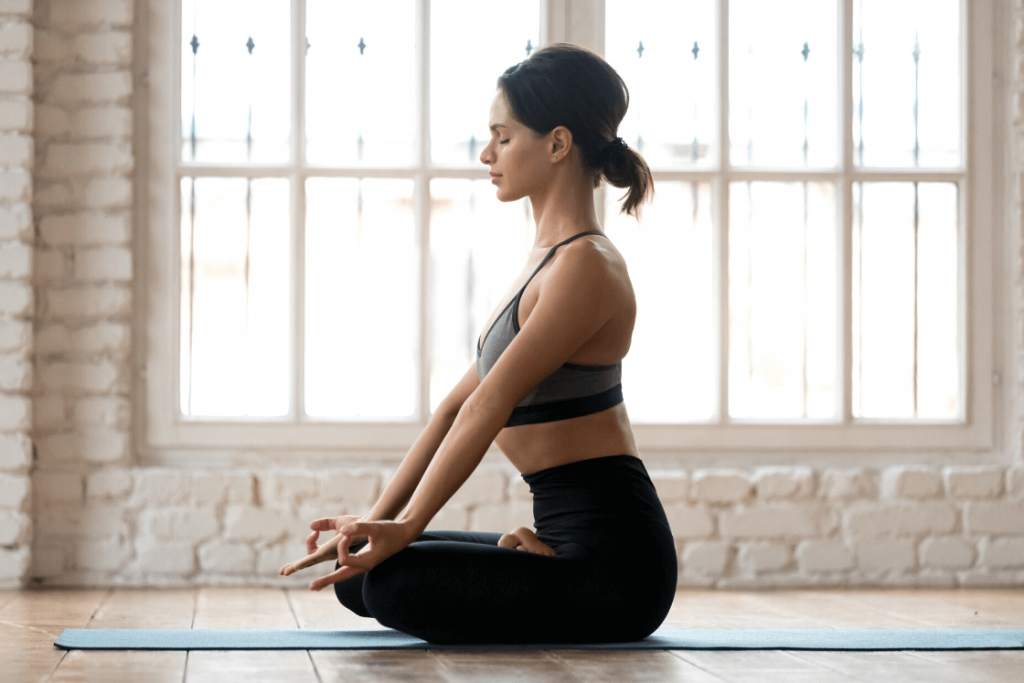
This breathing exercise is particularly beneficial for diabetic patients struggling with obesity. It burns fat through its rapid breathing mechanism and stimulates internal abdominal organs and glands to help regulate blood sugar levels.
How to do Kapalbhati:
- Sit in a comfortable posture (sukhasana, padmasana, siddhasana).
- Place hands over knee cap, simply in relaxing posture or in Gyan mudra.
- Now take a deep breath in through nostrils and feel the belly-filling up with it.
- Place your right hand over the belly and with little force, exhale by pushing the abdominal wall in toward spine producing a ‘hiss’ sound. Then inhale will come automatically.
- Experience the blow of air through your upper body.
- Repeat step 4, rapid exhale → automatic inhale for 10 rounds.
Gradually return back to the normal breathing pattern and relax your body.
How kapalbhati pranayama help in diabetes?
- The rapid abdominal movements in Kapalbhati act as a massage for internal organs, including the pancreas, which aids in the secretion of insulin.
- Kapalbhati enhances blood flow to cells, boosting overall metabolism.
- The vigorous nature of the practice burns excess calories and reduces body fat, helping to lower the BMI and improve insulin sensitivity.
- This breathing technique promotes sweating, which helps eliminate toxins that can contribute to insulin resistance.
4. Sitali and Sitkari Pranayama
Sitali and sitakari are two traditional pranayama techniques from Hatha Yoga. Their cooling effects help lower blood pressure, which can be beneficial for managing diabetes.
How to do Sitali:
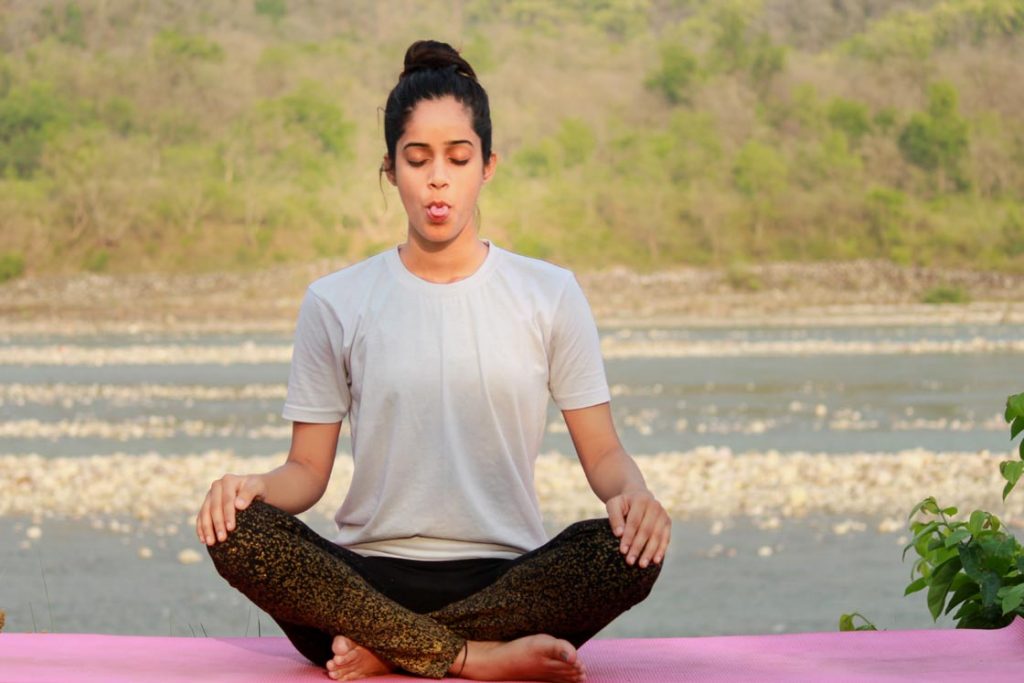
- Sit with straight spine either in a cross-legged posture like Padmasana or on a chair with feet resting on the ground.
- Roll your tongue, open your mouth, and place the rolled tongue in between your lips.
- Take a deep breath in through rolled tongue. Feel the moisten air entering through the mouth into the throat.
- After complete inhale, flat your tongue to the normal and exhale out through nostrils.
- Repeat steps 3 and 4 for 20 rounds.
Sitali Pranayama has a calming effect on stress and anxiety. Practicing it in the summer can lower body temperature by 3-4%.
Read more: Benefits of Sitali Pranayama
To do Sitakari:
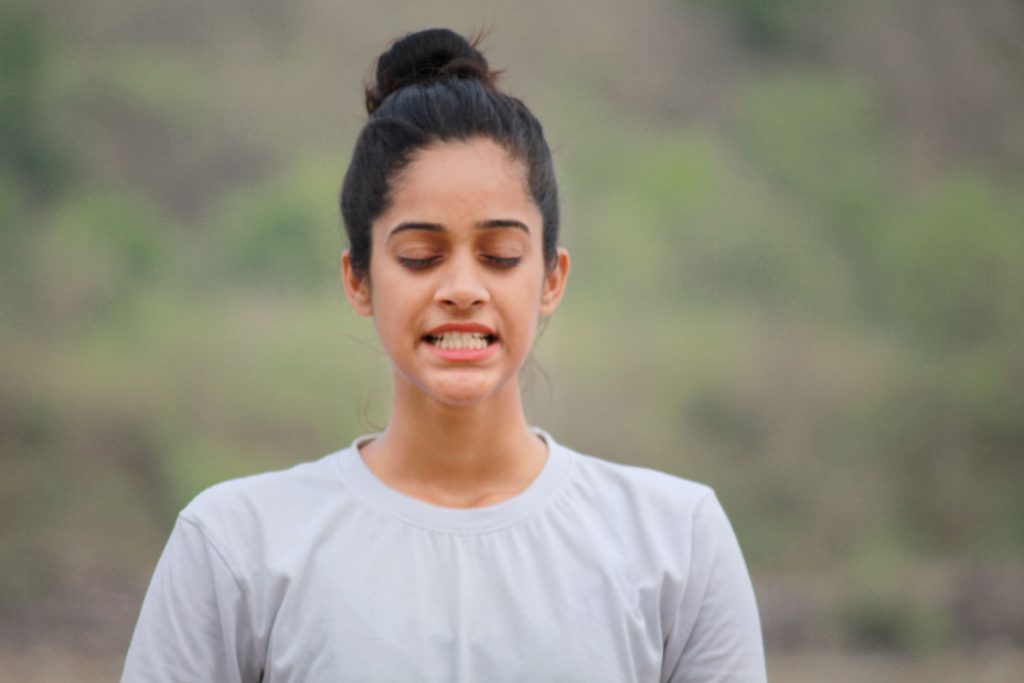
- Sit comfortably in the same posture as in sitali pranayama.
- Gently press your upper and lower teeth together and open up your lips.
- In the mouth, curly your tongue up in such a manner that the lower part of the tongue touches the upper palate.
- Now inhale with your open lips, air entering through space in between your teeth.
- On the exhalation, close your lips and breath out completely through nostrils.
- Repeat inhale & exhale in this manner for 20 rounds.
Sitakari Pranayama is especially helpful for diabetes symptoms related to obesity. Practising this breathing exercise a few times a day can reduce hunger pangs and quench thirst.
Read more: Benefits of Sitkari
5. Anulom Vilom Pranayama

In diabetic patients, inactivity in blood vessels can easily lead to nerve damage. To improve neuronal activity, deep breathing techniques such as Pranayama are very effective.
Anulom Vilom, also known as alternate nostril breathing, is a deep breathing technique that enhances the circulation of oxygenated blood to the brain in diabetic patients.
How to do anulom vilom:
- Find a peaceful space and sit in a simple meditative posture like Sukhasana.
- Make nasika mudra with your right hand: fold index & middle finger and keep the thumb, ring & little finger extended.
- Now bring your right hand close to the nostrils and shut your right nostril with the thumb (while left nostril open).
- Take a deep breath in through the left nostril and at the end inhalation, close left nostril with the ring and little finger.
- Open the right nostril and exhale out complete air.
- This time with left nostril closed, inhale through the right nostril and in next cycle, breath out through left nostril.
- Breath alternatively in this manner for 10 rounds.
Read more: Benefits of Anulom Vilom Pranayama
Conclusion
Diabetes can progress from Type 1 to Type 2 if the underlying factors are not addressed in time. Diabetes also increases the risk of other serious health conditions such as coronary heart disease, angina pectoris, and diabetic neuropathy.
Pranayama, an ancient Indian breathing technique, offers significant benefits for managing diabetes. Controlled breathing can positively impact various aspects of diabetes management.
Incorporating pranayama into your daily routine can be an effective, side-effect-free approach to managing diabetes. Regular practice of pranayama can help improve diabetes management and potentially support healing at any stage of the condition.


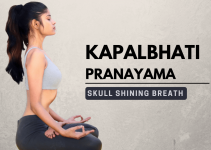
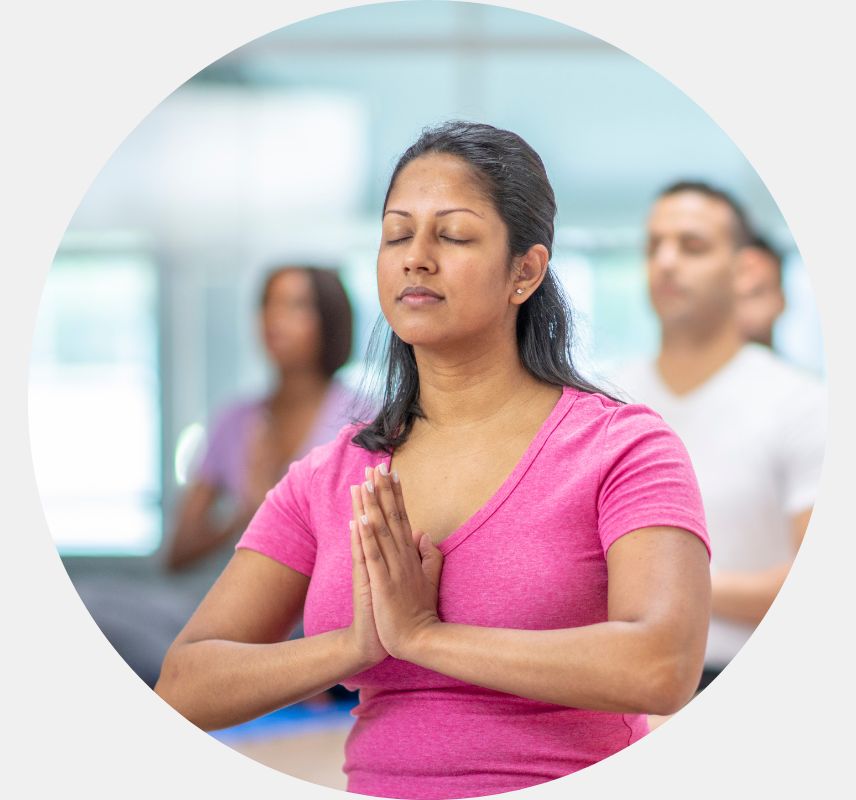

Namaste Ashish
Thank you for an amazing information about yoga pranayama and mudras. Can we do Anulom vilom lying down before bed?
pls share your knowledge
thank you
Yes, Anulom Vilom can be done at least half an hour before bed. The sitting positions are more appropriate for any type of pranayama, however, if you have some conditions due to which you can’t practice it sitting, yes it can be done in lying down position. For more info: check this article on Anulom Vilom Pranayama.
So you start from today. i do pranayam everyday
Excelent article!